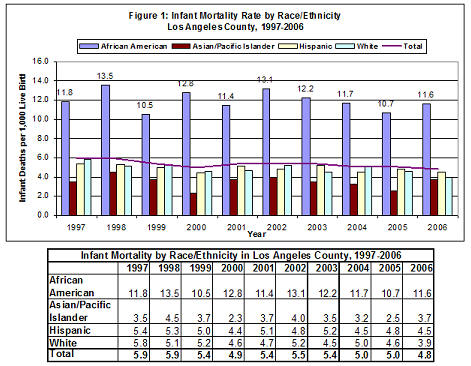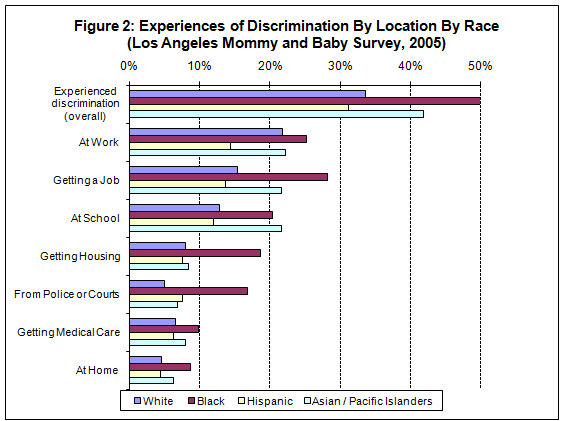Infant Mortality and Los Angeles County
Infant Mortality and Los Angeles County
Reducing and eliminating racial and ethnic
disparities in infant mortality in Los Angeles County (LAC) is
a significant priority for both LAC and
California State public health departments.
In 1989 LAC was among the first health jurisdictions
to receive funding from the State to create
the Black Infant Health Program to provide
a culturally specific perinatal intervention
to African American mothers and infants
in LAC. In 1994, LAC Fetal Infant Mortality
Review (FIMR) Project, one of the 12 California
county programs, was implemented to address
the problem of fetal and infant death in
areas with high rates of perinatal mortality.
The Healthy People 2010 objective is to
reduce the infant mortality rate to no more
than 4.5 per 1,000 live births.1
The infant mortality rate for LAC has had
a downward trend for the past ten years
(See Figure 1), going from 5.9 deaths per
1,000 live births in 1997 to 4.8 deaths
per 1,000 live births in 2006.2
Nevertheless, racial and geographic disparities
in infant mortality and adverse birth outcomes
persist. Compared to the overall LAC infant
mortality rate, the 2006 rate for African
Americans was significantly higher, at 11.6
deaths per 1,000 live births in 2006. In
other words, the infant mortality rate for
African Americans was more than two times
the rate for Los Angeles County overall.
African Americans comprised 7.6% of all
births in LAC in 2006, and 18.2% (134 cases)
of all infant deaths within the same period.3
More specifically, nationally, Black infants
are 2.4 times as likely to die in the first
year of life as White babies.4 In comparison,
African American babies in LAC are approximately
three times (2.97) as likely to die as White
babies in LAC.3
With such a large disparity
ratio, LAC provides an ideal target population.

Among the eight geographic regions within
LAC, both the Antelope Valley and South
regions had the highest infant mortality
rates in 2006 (7.6 and 5.5 infant deaths
per 1,000 live births, respectively). The
infant death rates for African Americans
in Antelope Valley and South regions were
as high as 18.3 per 1,000, while other racial/ethnic
groups had rates close to 5 per 1,000 live
births.
As indicated by a needs assessment completed
by LAC Maternal, Child, and Adolescent (LACMCAH)
programs in 2004, LAC lacked comprehensive
information with which to explore the association
between racism and adverse birth outcomes
until the advent of the Los Angeles Mommy
and Baby (LAMB) project in late 2004 and
Los Angeles Health Overview of a Pregnancy
Event (LA HOPE) in 2005.5,6,7
Using information collected
for these projects, LACMCAH has started
to assess the prevalence of experiences
of racism by mothers of different racial
backgrounds.
Findings from LAMB and LA HOPE show that
half of the African American mothers who
recently gave birth, experienced discrimination,
compared to other racial or ethnic groups.
The disparity in experience of discrimination
was most apparent when mothers sought jobs
and assistance from police or courts. With
respect to school campuses, however, Asian/Pacific Islanders reported the most discrimination
(Figure 2).3

Such experiences with discrimination could
directly and indirectly contribute to infant
mortality in LAC. LACMCAH has the ability
to examine the above hypothesis using data
collected as part of the LAMB and LA HOPE
projects. Although data collection has continued
since 2004 despite scarce resources,
data analysis has largely been delayed.
It is critical now for LACALC to conduct
an in-depth analysis to explore the association
between racism and adverse birth outcomes
in LAC. This information will be extremely
useful for community stakeholders to design
effective prevention and intervention strategies
to address racism in the field of maternal
and infant health.
References
1. Healthy People 2010. Maternal, Child,
and Infant Health. Retrieved on September
3, 2008: http://www.healthypeople.gov/document/HTML/Volume2/16MICH.htm#_Toc494699659
2. Los Angeles County Department of Public
Health. Maternal, Child, and Adolescent
Programs. Unpublished data 2008a.
3. Los Angeles County Department of Public Health.
Maternal, Child, and Adolescent Programs.
Unpublished data 2008b.
4. Mathews TJ, MacDorman
MF. Infant mortality statistics from the
2005 period linked birth/infant death data
set. National vital statistics reports;
vol 57 no2. Hyattsville, MD: National Center
for Health Statistics. 2008.
5. Los Angeles County Department of Public Health. Five-Year
Plan, 2005. Unpublished.
6. Los Angeles County Department of Public Health. Maternal,
Child, and Adolescent Programs. Retrieved
on September 3, 2008: http://publichealth.lacounty.gov/mch/lamb/LAMB.html
7. Los Angeles County Department of Public
Health. Maternal, Child, and Adolescent
Programs. Retrieved on September 3, 2008: http://publichealth.lacounty.gov/mch/LAHOPE/LAHOPE.html




